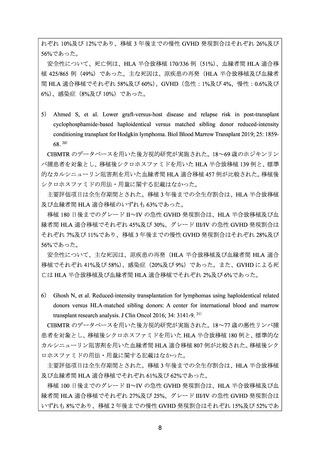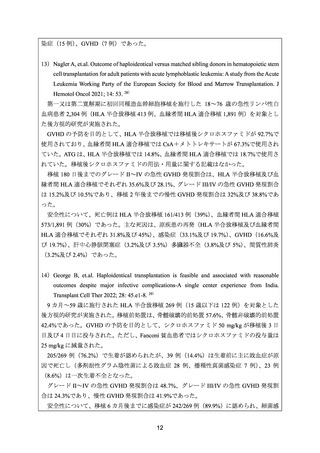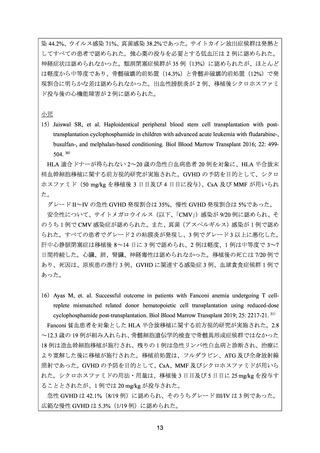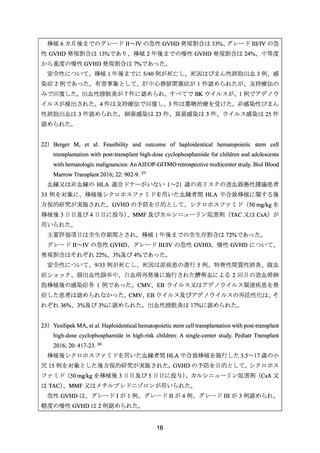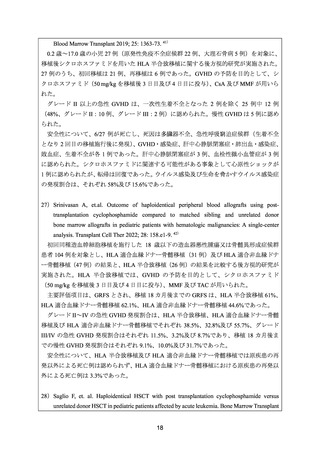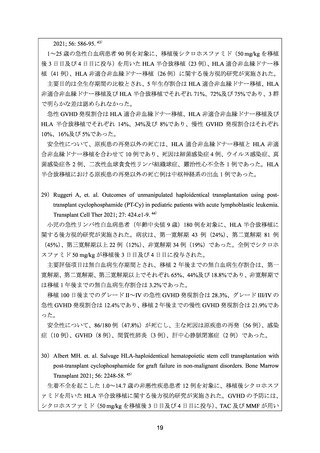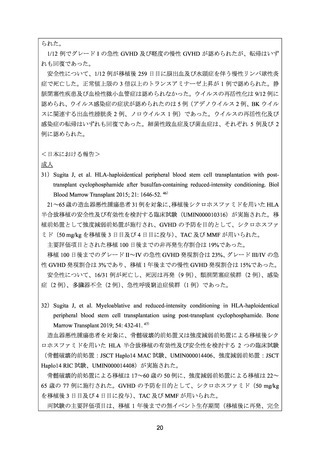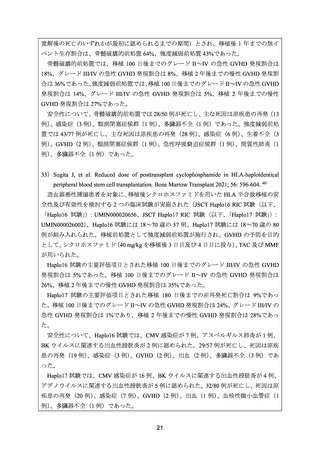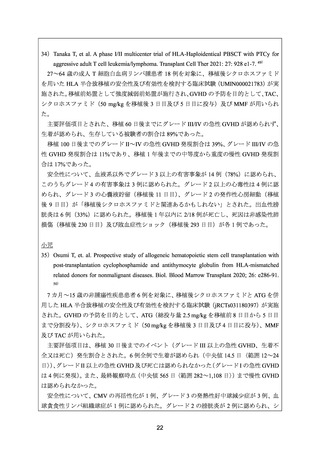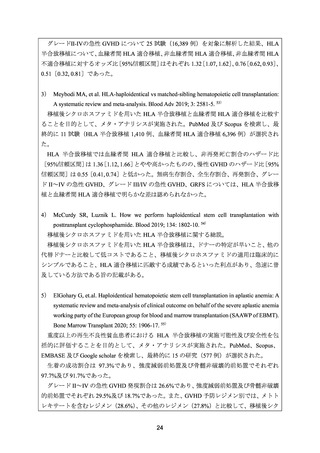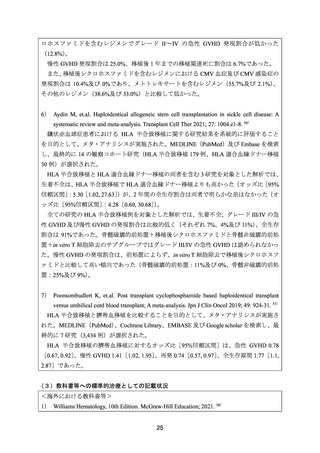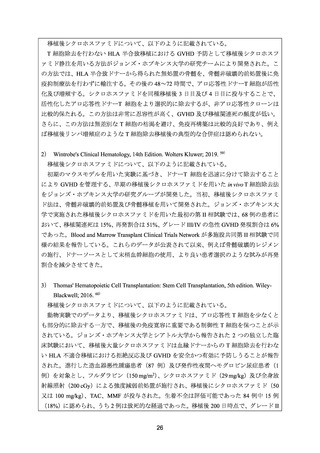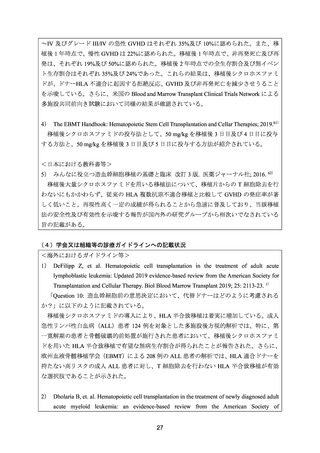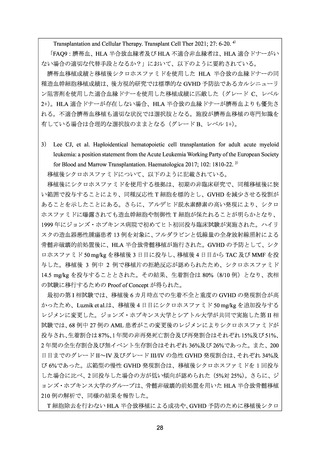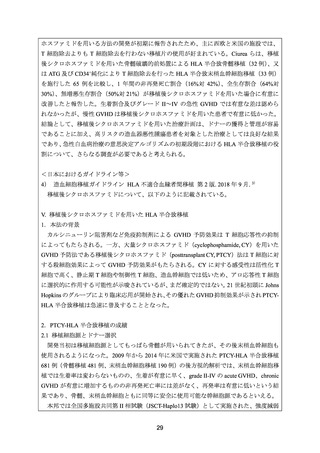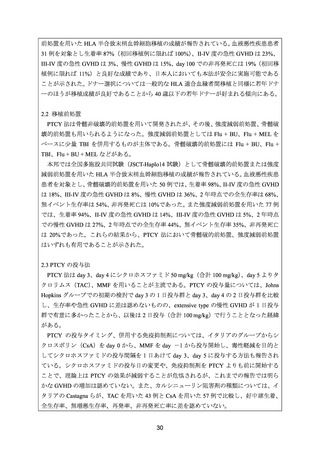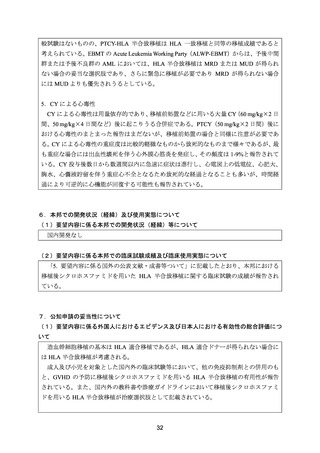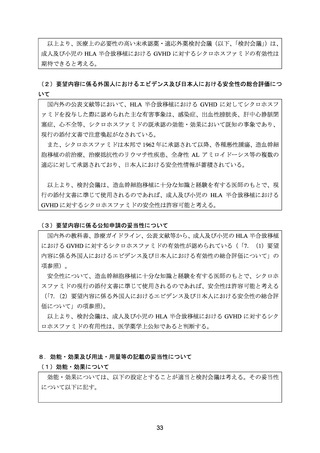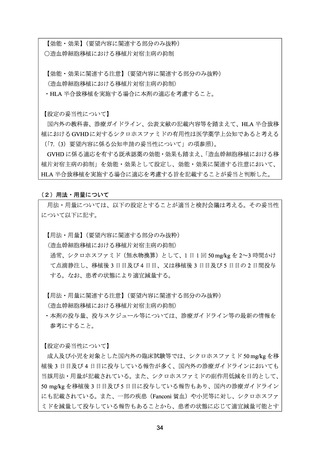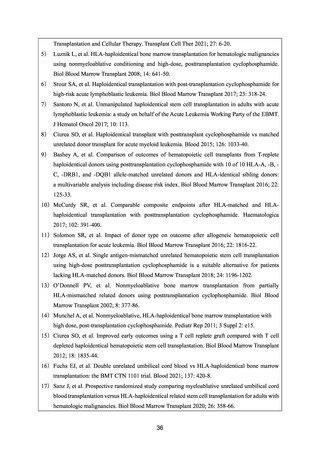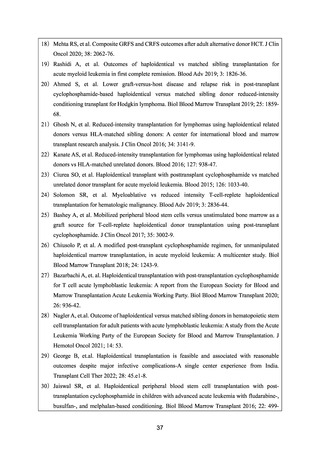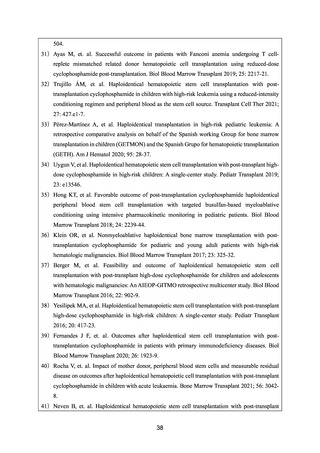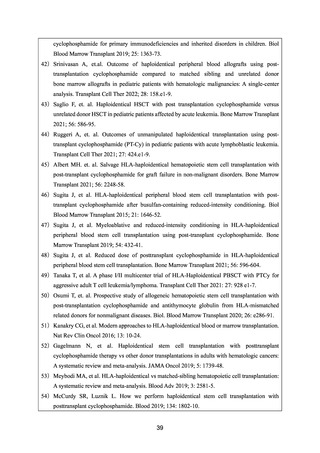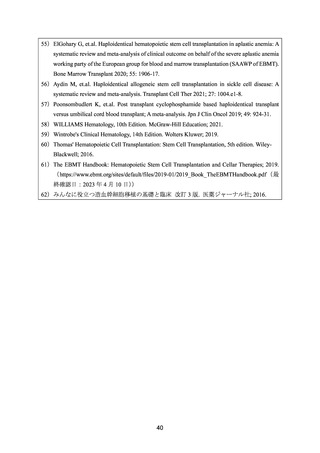よむ、つかう、まなぶ。
資料4 シクロホスファミド水和物 (39 ページ)
出典
| 公開元URL | https://www.mhlw.go.jp/stf/shingi2/0000198856_00027.html |
| 出典情報 | 医療上の必要性の高い未承認薬・適応外薬検討会議(第55回 5/31)《厚生労働省》 |
ページ画像
ダウンロードした画像を利用する際は「出典情報」を明記してください。
低解像度画像をダウンロード
プレーンテキスト
資料テキストはコンピュータによる自動処理で生成されており、完全に資料と一致しない場合があります。
テキストをコピーしてご利用いただく際は資料と付け合わせてご確認ください。
cyclophosphamide for primary immunodeficiencies and inherited disorders in children. Biol
Blood Marrow Transplant 2019; 25: 1363-73.
42) Srinivasan A, et.al. Outcome of haploidentical peripheral blood allografts using posttransplantation cyclophosphamide compared to matched sibling and unrelated donor
bone marrow allografts in pediatric patients with hematologic malignancies: A single-center
analysis. Transplant Cell Ther 2022; 28: 158.e1-9.
43) Saglio F, et. al. Haploidentical HSCT with post transplantation cyclophosphamide versus
unrelated donor HSCT in pediatric patients affected by acute leukemia. Bone Marrow Transplant
2021; 56: 586-95.
44) Ruggeri A, et. al. Outcomes of unmanipulated haploidentical transplantation using posttransplant cyclophosphamide (PT-Cy) in pediatric patients with acute lymphoblastic leukemia.
Transplant Cell Ther 2021; 27: 424.e1-9.
45) Albert MH. et. al. Salvage HLA-haploidentical hematopoietic stem cell transplantation with
post-transplant cyclophosphamide for graft failure in non-malignant disorders. Bone Marrow
Transplant 2021; 56: 2248-58.
46) Sugita J, et al. HLA-haploidentical peripheral blood stem cell transplantation with posttransplant cyclophosphamide after busulfan-containing reduced-intensity conditioning. Biol
Blood Marrow Transplant 2015; 21: 1646-52.
47) Sugita J, et al. Myeloablative and reduced-intensity conditioning in HLA-haploidentical
peripheral blood stem cell transplantation using post-transplant cyclophosphamide. Bone
Marrow Transplant 2019; 54: 432-41.
48) Sugita J, et al. Reduced dose of posttransplant cyclophosphamide in HLA-haploidentical
peripheral blood stem cell transplantation. Bone Marrow Transplant 2021; 56: 596-604.
49) Tanaka T, et al. A phase I/II multicenter trial of HLA-Haploidentical PBSCT with PTCy for
aggressive adult T cell leukemia/lymphoma. Transplant Cell Ther 2021: 27: 928 e1-7.
50) Osumi T, et. al. Prospective study of allogeneic hematopoietic stem cell transplantation with
post-transplantation cyclophosphamide and antithymocyte globulin from HLA-mismatched
related donors for nonmalignant diseases. Biol. Blood Marrow Transplant 2020; 26: e286-91.
51) Kanakry CG, et al. Modern approaches to HLA-haploidentical blood or marrow transplantation.
Nat Rev Clin Oncol 2016; 13: 10-24.
52) Gagelmann N, et al. Haploidentical stem cell transplantation with posttransplant
cyclophosphamide therapy vs other donor transplantations in adults with hematologic cancers:
A systematic review and meta-analysis. JAMA Oncol 2019; 5: 1739-48.
53) Meybodi MA, et al. HLA-haploidentical vs matched-sibling hematopoietic cell transplantation:
A systematic review and meta-analysis. Blood Adv 2019; 3: 2581-5.
54) McCurdy SR, Luznik L. How we perform haploidentical stem cell transplantation with
posttransplant cyclophosphamide. Blood 2019; 134: 1802-10.
39
Blood Marrow Transplant 2019; 25: 1363-73.
42) Srinivasan A, et.al. Outcome of haploidentical peripheral blood allografts using posttransplantation cyclophosphamide compared to matched sibling and unrelated donor
bone marrow allografts in pediatric patients with hematologic malignancies: A single-center
analysis. Transplant Cell Ther 2022; 28: 158.e1-9.
43) Saglio F, et. al. Haploidentical HSCT with post transplantation cyclophosphamide versus
unrelated donor HSCT in pediatric patients affected by acute leukemia. Bone Marrow Transplant
2021; 56: 586-95.
44) Ruggeri A, et. al. Outcomes of unmanipulated haploidentical transplantation using posttransplant cyclophosphamide (PT-Cy) in pediatric patients with acute lymphoblastic leukemia.
Transplant Cell Ther 2021; 27: 424.e1-9.
45) Albert MH. et. al. Salvage HLA-haploidentical hematopoietic stem cell transplantation with
post-transplant cyclophosphamide for graft failure in non-malignant disorders. Bone Marrow
Transplant 2021; 56: 2248-58.
46) Sugita J, et al. HLA-haploidentical peripheral blood stem cell transplantation with posttransplant cyclophosphamide after busulfan-containing reduced-intensity conditioning. Biol
Blood Marrow Transplant 2015; 21: 1646-52.
47) Sugita J, et al. Myeloablative and reduced-intensity conditioning in HLA-haploidentical
peripheral blood stem cell transplantation using post-transplant cyclophosphamide. Bone
Marrow Transplant 2019; 54: 432-41.
48) Sugita J, et al. Reduced dose of posttransplant cyclophosphamide in HLA-haploidentical
peripheral blood stem cell transplantation. Bone Marrow Transplant 2021; 56: 596-604.
49) Tanaka T, et al. A phase I/II multicenter trial of HLA-Haploidentical PBSCT with PTCy for
aggressive adult T cell leukemia/lymphoma. Transplant Cell Ther 2021: 27: 928 e1-7.
50) Osumi T, et. al. Prospective study of allogeneic hematopoietic stem cell transplantation with
post-transplantation cyclophosphamide and antithymocyte globulin from HLA-mismatched
related donors for nonmalignant diseases. Biol. Blood Marrow Transplant 2020; 26: e286-91.
51) Kanakry CG, et al. Modern approaches to HLA-haploidentical blood or marrow transplantation.
Nat Rev Clin Oncol 2016; 13: 10-24.
52) Gagelmann N, et al. Haploidentical stem cell transplantation with posttransplant
cyclophosphamide therapy vs other donor transplantations in adults with hematologic cancers:
A systematic review and meta-analysis. JAMA Oncol 2019; 5: 1739-48.
53) Meybodi MA, et al. HLA-haploidentical vs matched-sibling hematopoietic cell transplantation:
A systematic review and meta-analysis. Blood Adv 2019; 3: 2581-5.
54) McCurdy SR, Luznik L. How we perform haploidentical stem cell transplantation with
posttransplant cyclophosphamide. Blood 2019; 134: 1802-10.
39







